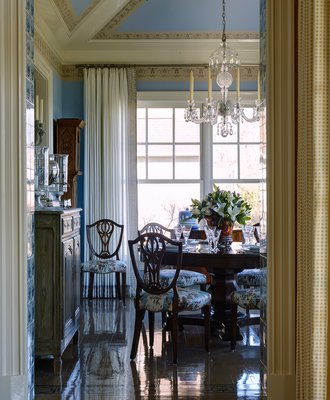
The tips of my fingers were numb despite being covered with sheepskin gloves and stuffed into my coat pocket. Nose and toes were frozen along the same guidelines. So I wondered how foolish I was to be standing outside on New York’s coldest winter day in a two-block-long queue 45 minutes before my appointed half-hour admission to the “Downton Abbey” exhibition.
I had been dragged there by Paul, who insisted that if we had spent every wintery Sunday evening for five years glued to the PBS miniseries, we were damn well going to experience these sets and costumes.
Not surprisingly, the sets the Brits had shipped over for the exhibition were the kitchens, servant’s quarters, eating hall and head butler Carson’s office. These sets had all been dreamed up at a remote studio. The extravagant living room, dining room, library and bedrooms were, of course, the actual chambers from Highclere Castle, renamed Downton Abbey for the series.
The advent of high-definition television has initiated challenges to not only vanity-prone actors, whose not-so-perfect skin is alarmingly magnified, but also set designers and costume designers, whose sets and costumes, come under magnified scrutiny. The demand for accuracy has become paramount, and the producers of “Downton Abbey” demanded nothing less.
As we walked through the scullery, observing the weathered and chipped wainscoting, the iron latches on the oven doors, the worn banister rail, and the hand-polished brass spirals on the room bells, we were astonished with the verisimilitude of it all. One could only admire the thought, the problem-solving, and the foresight that each craftsman laboring on these sets must have contributed.
This meticulous creativity extended to the costuming itself, which simply did not appear as costumes, but clothing. The beadwork, the period fabrics, and the tonalities astonished. The hats and the suits were striking (by the way, Thomas was slenderer then you might imagine, and Violet, much shorter). The shoes, boots, and jewelry, so specific to the period, amazed you with their beauty, creativity and foreignness.
What makes these set, costume and accessory designers so extraordinary is their conscious election not to editorialize, romanticize or generalize the period. For instance, not all dresses from the 1920s were flattering (take Edith’s clothing) and not all hats were perfect.
What made the residence itself (Highclere Castle) so fascinating was simply that every object, painting, chair, carpet and curtain was not from the same period. It was an accumulation of generations of families, generations of taste, generations of fashion, and generations of editing. With a house like that, as the Lord Grantham put it, “You are merely a steward, not an owner.” To be said another way, a home like this owns you. (One may be certain that many homeowners of very large estates here on the East End may feel the same.)
On the flipside, we are all “stewards” of the homes and objects we own and therefore in the last 10 years of writing this column, I have always championed quality over quantity, restoration over renovation, and “home” over house.
I have a relished keeping abreast of what is innovative, what is thoughtfully rethought, and what is sincerely creative. And though eagerly looking to the future, I have reminded myself (and those who have so patiently read my words), that the past is our treasure trove, our enlightening inheritance, that constantly inspires and reignites our imagination and our love of home.
When I was a young designer, I wanted to make grand statements, bold moves, rip out and rebuild, erect my visual mark on the landscape. With time though, I have chosen to listen first, perceive, evaluate and finally respect the context before I design. For instance, before I destroy a butler’s pantry, I ask myself, how was it useful and could it be useful again, and is it beautiful still? Before I ship off to auction a perfectly proportioned, exquisitely veneered, 18th century chest, I ask, “How can I use its clean lines in a modern interior?” Rethinking, reusing and reimagining are all part of the creative process.
In the race to be cutting edge, the wholesale trashing of all that we have inherited or accumulated may be cleansing, but sometimes it bleaches the soul. Viewed from another vista, we don’t want our homes to “own us” as Downton Abbey owns Lord Grantham, but at the same time discarding all that is past weakens our future.
I do leave the readers of this column with a plea to respect and value our architectural history and heritage here on the East End. This architectural history and heritage is truly what makes the Hamptons distinctive from other beautiful seaside environments.
Re-envisioning and restoring our buildings and residential houses is far more innovative and rewarding than “scrapping“ them.
Again, I encourage you to thoughtfully design and purchase for the long run, not just “make do” with furnishings that will not stand the test of time, ending up thrown into our already over brimming landfills.
Concluding with gratitude my decade-long column, I leave the readers with thoughts from those who have inspired me:
“Comfort is the ultimate luxury.” – Billy Baldwin
“If it’s well crafted, creative, and beautiful, it will endure.” – Holmes Easley
“Get the proportion right and the rest falls in line. It’s all about proportion.” – Gary Crain
“Respond to the timeless, rather than the immediate.” – “The Art of Elegance”
“A house is just a house, until you make it home.” – Sally Watson